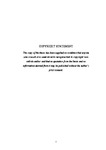Organic nitrogen uptake by marine algae: consequences for marine ecosystem functioning and biodiversity
| dc.contributor.supervisor | Fitzsimons, Mark | |
| dc.contributor.author | Raccagni, Monica | |
| dc.contributor.other | School of Geography, Earth and Environmental Sciences | en_US |
| dc.date.accessioned | 2018-11-19T17:11:24Z | |
| dc.date.available | 2018-11-19T17:11:24Z | |
| dc.date.issued | 2018 | |
| dc.date.issued | 2018 | |
| dc.identifier | 10511388 | en_US |
| dc.identifier.uri | http://hdl.handle.net/10026.1/12816 | |
| dc.description.abstract |
Dissolved organic nitrogen (DON) represents a major pool of fixed, reactive nitrogen in marine systems. It is now recognized that this pool can support primary production and the ability of some algal species to exploit DON compounds as sources of Nitrogen (N) may indicate that specific DON components can exert selective pressure on the composition of the phytoplankton community. In this study the ability of monocultures of ecologically-relevant algal species from the English Channel (Emiliania huxleyi, Micromonas pusilla, Alexandrium minutum and Chaetoceros peruvianus) to grow with DON as the only N source was examined using different artificial media. Among the two tested artificial seawater recipes, Aquil* was preferred as it contained lower micronutrient concentrations, and gave better growth results for all used species. In order to constrain the DON uptake to algae alone, a method for bacterial removal was tested using antibiotic additions. Both Slocombe antibiotic mixture (Cefotaxime-Carbenicillin-Kanamycin-AugmentinTM) and Penicillin-Streptomycin-Neomycin used were effective and not toxic to the algae. Incubation with the antibiotic up to 48 hours and a transfer period into antibiotic-free medium after 72 hours proved to be effective. However, the treatment removed bacteria in A. minutum cultures only; further treatment would be required for the other species to be cultured axenically. The ability to use DON was tested for the above mentioned species using the amino acid L-Arginine (ARG) as the sole N source, and growth was compared with nitrate-containing cultures of the same species. All the selected species grew in both NOᴈ‾ and in ARG, reaching lower final densities when incubated with ARG, although these were not significant. This study has shown that E. huxleyi, A. minutum, M. pusilla and C. peruvianus can grow on organic N, either by direct or indirect uptake, and develop comparable biomasses to species using inorganic N. Both C. peruvianus and M. pusilla cultures contained dissolved ammonium at the end of the experimental period, indicating potential indirect use by the algae of organic N converted to inorganic N by bacteria. A. minutum grew in the presence of ARG along with the cosmopolitan E. huxleyi; N-demand estimates, based on the molar concentration of N-ARG consumed, correlated with the final cell density, indicating that the species did not develop on inorganic N produced from ARG mineralisation, but directly on the ON substrate. Since A. minimum has been linked to harmful algal blooms, and E. huxleyi contributes significantly to oceanic CaCOᴈ deposition, their ability to utilise DON has environmental consequences in addition to the oceanic N-budget. Climate change scenarios predict both episodic conditions of elevated rainfall and extended periods of dry conditions leading to variable riverine inputs to coastal areas, altered nitrogen to phosphorus (N:P) ratios, and changes in the inorganic to organic balance of the nutrient pools. Organic N can constitute up to 69 % of the total N pools, respectively, making it crucial, to understand the cycling of this fraction in coastal waters, and how changes in the composition of nutrient pools could impact on marine ecosystem function and health. | en_US |
| dc.language.iso | en | |
| dc.publisher | University of Plymouth | |
| dc.subject | Phytoplankton | |
| dc.subject | Bacteria | |
| dc.subject | Nitrogen uptake | |
| dc.subject | Dissolved organic nitrogen | en_US |
| dc.subject.classification | MPhil | en_US |
| dc.title | Organic nitrogen uptake by marine algae: consequences for marine ecosystem functioning and biodiversity | en_US |
| dc.type | Thesis | |
| plymouth.version | publishable | en_US |
| dc.identifier.doi | http://dx.doi.org/10.24382/957 | |
| dc.rights.embargoperiod | No embargo | en_US |
| dc.type.qualification | Masters | en_US |
| rioxxterms.funder | Not available | en_US |
| rioxxterms.identifier.project | MARES Joint Doctoral Program FPA 2011-0016 | en_US |
| rioxxterms.version | NA |
Files in this item
This item appears in the following Collection(s)
-
01 Research Theses Main Collection
Research Theses Main


